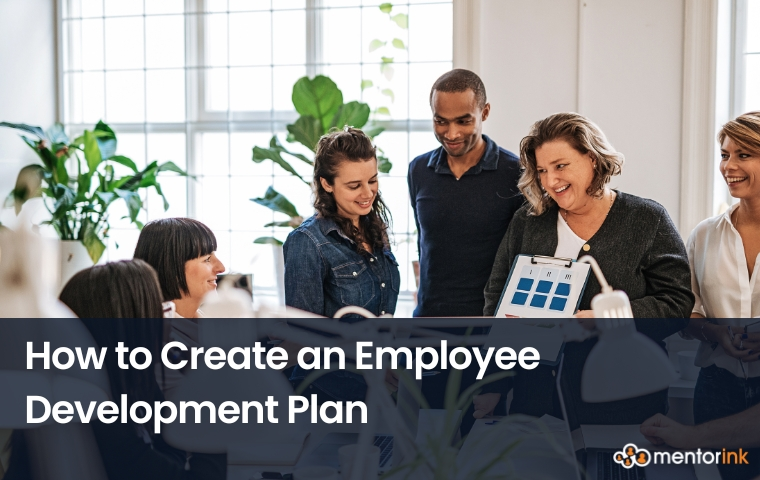
Creating an employee development plan is not just a task on a checklist. Development is not an option; it is a necessity for businesses that genuinely wish to expand, remain ahead of the curve, and retain their best employees.
Employees become more engaged, motivated, and dedicated to the company’s mission when they perceive that their professional and personal development is being supported.
However, how to actually create a development plan that produces outcomes is the true question. One that aligns individual aspirations with business goals, offers clear learning paths, and evolves with each employee’s journey? It starts with listening, setting meaningful goals, offering the right tools and support, and consistently following through.
What is Employee Development Plan?
An employee development plan is a structured approach designed to help employees improve their skills, grow in their roles, and advance their careers within an organization. It is more than just a list of training classes and sporadic feedback sessions. An employee development plan is also a deliberate strategy to align an individual’s growth with the company’s objectives.
At its core, an employee development plan identifies where an employee is now, where they could be in the future, and what steps are needed to get there. It includes clear goals, timelines, and measurable outcomes. When done right, it benefits both the individual and the organization.
Benefits of Implementing Employee Development Plan
Employee development plans benefit both employees and employers. A well-planned employee development plan can change the situation in the workplace in a positive way.
Employee Growth and Career Development
When companies invest in the growth of their people, they set up a cycle of mutual success. Employees get a chance to sharpen their skills, explore new career paths, and take on more responsibility. This fuels personal fulfillment and builds a stronger, more adaptable workforce.
Advancement is not the only aspect of career development. It is also about preparing employees for lateral moves, cross-functional roles, and new challenges. Employees who see a clear path forward tend to stay longer and contribute more. Career development is a part of employee development plan. “Questions About Career Development” can help you to understand more about what is career development exactly.
Better Job Satisfaction
Job satisfaction also improves when employees feel seen, valued, and challenged in the right way. A development plan helps employees understand their role in the bigger picture and gives them a sense of direction. When employees know they are working toward something meaningful, they tend to feel more satisfied with their work.
Employee Engagement
Engaged employees are proactive, enthusiastic, and invested in their work. Development plans help achieve this by giving employees a stake in their own progress. Instead of drifting through tasks, they are building something like a skill set, a career, a future.
Engaged employees are more likely to support the company’s mission. Personal development plans that align with company objectives have the potential to energize teams and boost overall morale.
Better Job Performance
Training and development plans are closely tied to performance improvement. Employees gain the tools they need to perform better in their current roles. Whether it’s technical skills, leadership abilities, or soft skills like communication, a targeted plan can create significant gains.
When performance improves, productivity increases. This has a direct impact on the company’s bottom line. Development is not just an expense—it’s an investment that pays off.
Types of Employee Development Programs
There is no one-size-fits-all approach to employee development programs. Depending on your company’s goals and employee needs, you can choose a variety of development options.
Skills Development
Skills development is all about enhancing specific technical or soft skills. For instance, a customer support rep may undergo communication training, or an IT staffer might get certified in new software.
Employees who need to keep up with changes in technology, market demands, or internal processes benefit greatly from skill development.
Performance Development Plan
A performance development plan focuses on closing the gap between current performance and expectations. These plans often arise after a performance review and are personalized to help an employee overcome challenges and meet their goals.
Leadership Development Programs
Not everyone is born a leader but many can become one with the right guidance. These programs identify potential leaders early and help them build critical leadership skills like communication, decision-making, and emotional intelligence. Companies looking to promote from within should absolutely consider implementing leadership development tracks.
High Potential Development Programs
Often called “HiPo” programs, these are designed for employees identified as having the potential to take on critical roles in the future. These individuals get access to coaching, high-stakes projects, and direct mentorship from senior leaders.
Succession Planning
The reality is, no one stays forever. Succession planning helps prepare future leaders by identifying potential candidates early and equipping them through personalized training, mentoring, and shadowing so they are ready when key roles need to be filled.
How to Create a Successful Employee Development Plan
Rather than hiring all external candidates for management positions, companies should focus on developing their internal staff. Promoting from within boosts employee morale, increases loyalty, and reduces recruitment and training costs. It allows companies to build on existing talent, ensuring managers already understand the company’s culture, operations, and goals.
Creating a Strategy
First things first, you need a clear vision. You can begin with aligning your development goals with your company’s broader objectives. Ask questions like
- What are our future skill needs?
- Which roles are evolving?
- Where do we see growth opportunities?
Once you have mapped this out, assess your current workforce. Identify skills gaps, potential leaders, and individual career goals. This helps tailor plans that are both personal and strategic.
You should not forget to involve employees in the process. You may ask them about their career ambitions, learning preferences, and what motivates them. The more involved they are, the more likely they are to commit.
Launching and Tracking of Employee Development Plan
Once the strategy is ready, it’s time to roll it out. Make sure each employee has a clearly defined development path with measurable goals, deadlines, and checkpoints.
By using HR software or even simple tracking tools to keep tabs on progress. Offer workshops, courses, mentorships, and real-world projects that align with the plan.
Collection of Feedbacks from Your Employees
Feedback is often overlooked but it is essential in employee development programs. Regularly ask employees if the training is helpful, if they feel supported, and what could be better. When you listen and adjust based on their input, your program stays dynamic and effective, not just another HR policy.
How Mentoring Plays a Key Role in Employee Development Programs
Mentorship is a powerful tool that bridges the gap between training and practice in employee development. While training provides knowledge, mentoring shows how to apply that knowledge in real-life situations.
A good mentor does more than just guide; they share their own experiences and help overcome obstacles along the way. This process builds confidence and accelerates learning.
Mentorship also strengthens workplace relationships. It fosters intergenerational understanding and contributes to a culture that embraces growth and development.
In employee development programs, mentors help employees explore their career goals, set realistic objectives, and stay motivated to achieve them. This one-on-one support offers a depth that no online course can match.
From an organizational perspective, mentoring programs clearly signal a commitment to employee success. They support internal talent development, boost employee engagement, and enhance the overall sense of belonging.


